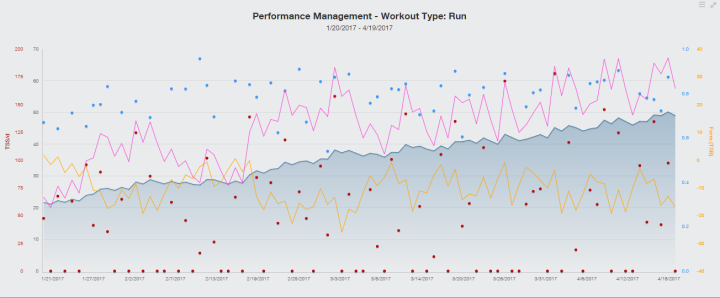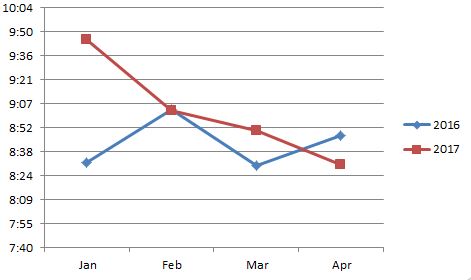What a GREAT weekend of racing! The Ironman scene was buzzing. The London Marathon was crazy after an equally crazy Marathon Monday in Boston. Records were falling left and right! (Oops, sorry. Starky too! 4:01 bike split, what?!)
To anyone who has asked, it has been easier to say my first race is in June which is the start of my tri season in Grand Rapids. But, when I was presented the opportunity to race with the Fleet Feet Racing Team this year it opened the door to test out this run training in a standalone effort first. Which led to me running the Ravenswood Run 5K this Sunday!
I want to get into the race, really I do, but I really want to touch on this run block we did all winter first. For those familiar with Training Peaks data here is the running fitness progression since January.

On its own this is a normal progression, but I was interested in three things as I look back on this block.
- I have run more days on this new plan than in the past. When compared to 2016 my days off from running were cut by 38%.
- My ramp rate stayed almost the same but I have more energy and feel fitter.
- My Intensity Factor (the blue dots) peaks and valleys are more pronounced than 2016.
Before races I like to do a data dive. It helps remind me where I have been and where I am presently, which allows me to set better expectations.
So first a little bit about the above takeaways and then a short race recap and lessons learned.
You have to run more and sometimes faster (I’ll get to that later) to run faster.
I always heard of this phenomenon of doing more to get better. It’s part of what sparked my change in training last August that I feel partially led to my success at Louisville. There are definitely times when doing more can hurt. Especially if you do it wrong. However, I do feel that in certain cases you will get better/faster if you just do more.
Although I have only run 20 more total miles, than in the same time frame in 2016, if you consider that I was training for the Boston Marathon in that time period last year it is significant.
The two changes to allow for this were:
- longer midweek runs and shorter weekend longish runs (1:30-2hrs max)
- running more days in a row/fewer days off
If you’re thinking, duh Lauren you said you are running faster and thus are able to run longer in a given period of time, you would be wrong. Garmin history shows my average run pace has not changed much at all. See comparison of 2016 to 2017 below.

Which brings me to my next point…
Vary your paces. Extremely.
You read blogs written by pros all the time that say amateurs don’t go slow enough on their recovery days. I am learning what that means myself and am by no means an expert, but I’m here to tell you it works if you do it right.
When my training plan says to “go easy” or stay in z2 I’m sometimes as chill as an 11:45 pace and I top out at a 9:50 min/mile. On the other end of the spectrum we have been touching this “theoretical best effort pace” at different intervals over the past 10 weeks where I’ve been trying to touch a 6min mile for the given interval. To give perspective, a 6 min mile is about where some of my competitors are running a 5K/10K, but stupid hard for me.
Neither of these circumstances is fun for me. I thrive at tempo and threshold pace. But after 10+ weeks of spending time in every single zone imaginable, something magical has started to happen to my threshold pace.
About 6 to 8 weeks in I was excited to see this workout show up in my schedule.
“Run 3 by 10 minutes at threshold pace.”
I hadn’t run much at threshold yet this winter as we started the year off by working on hills and when that was done we abruptly transitioned into this fast pace work.
I chose to run this on the treadmill to control my pace that morning. When the first interval came around I started at 7:20 pace. I was feeling too good, and by the end of the third interval I was almost touching 6:58 pace. I say almost because I convinced myself that 6:58 was too fast to be MY threshold pace. Needless to say I was pretty blown away at how easy this run felt at these paces.
As I mentioned earlier, the peaks and valleys of my Intensity Factor metric were more pronounced this year. Varying paces is what causes this, and when compared to last year my IF was virtually a straight line.
My interpretation of this is that I was just simply spending too much time in the same zone last year. Rarely touching my peak, and inversely never touching anywhere near that true recovery pace.
So, how did Ravenswood go?

I’m not sharing this analysis to toot my own horn. [Insert reminder that my peak pace is easily some women’s 5k.] ;) I’m acutely aware that as well as my run went at Louisville, that course played to my strengths. I’m up against some Ironman courses that present obstacles and challenges that I am not as familiar or confident with, so hopefully improving my running weaknesses should pay off in a few months.
My goals for the race:
- Rough estimate for pace was to run 6:35’s or better.
- Feel good about my effort.
- Keep my cadence above 180.
- Finish strong.
For the last three years I did my interval training at a 6:35 5k pace. I was pulling this from a loose prediction of my longer distance race paces. After never having strung even a mile together at this pace I set it as my time goal.
The last piece of my running improvement puzzle has been some cadence work, so I made a last minute addition, and set a cadence goal for myself too.
I’m happy to report I accomplished all four goals.
The race took off a little hot, due to how far in front I started. I was surprised, however, that when I would back off the pace I was recovering very quickly. So quickly that I would feel myself be able to push the pace again. These surges happened a few times throughout the race, I think mostly because running and pacing a 5k is so foreign to me.
There were a couple moments that I looked at my watch and saw a 6:33 average. In the past I know that would have discouraged me into thinking I was in trouble and not going to hit my goal. This time I was able to dig deep a couple times and push through those thoughts. However, if there’s one thing that I need to keep working on, it’s most certainly my confidence.
I finished the race in 20:09, sneaking under my pace goal with 6:28’s.

After crossing the finish line I didn’t have much left in the speed tank, but I happily warmed down with a few miles at marathon pace and felt like I could have run forever.
All in all I learned more about trusting the process this year than ever before. I am more comfortable with just letting things unfold and have a better understanding in the value of consistency.
A huge thanks to my coach for creating the master plan, that I not only believe in 100%, but is really starting to shape me into some kind of runner.
Another thanks goes out to Fleet Feet Sports for bringing me on the team, and supporting my run efforts for the 2017 season. I was welcomed back into the Chicago running scene on Sunday with open arms. Seeing everyone out at Ravenswood, it was like I never left, and I can’t wait to do it again at the Soldier Field 10 in a month!

Wow, great post! I’m so impressed by your hard work and a fantastic race, Lauren.
LikeLike
Thank you! It’s definitely starting to come together! :)
LikeLike
whoa!! you are an iron-woman! good luck with the race season!!
LikeLiked by 1 person
Great post and so great to see our superstar back on the local races. Have a great season!
LikeLiked by 1 person
Aww thanks! Sad to have missed you out there. Would be great to catch up!
LikeLike